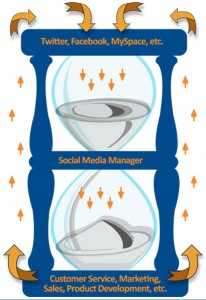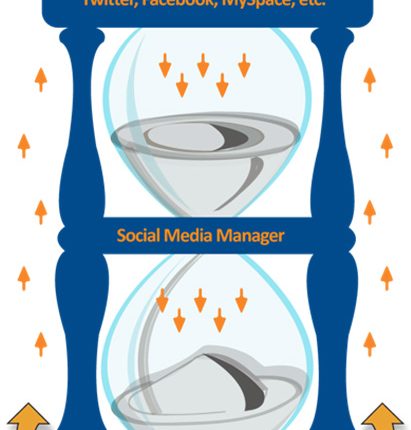Social Media for the COO: How to become the Michael Phelps of implementing social media in your organization
Many marketers can be separated into one of two camps when it comes to social media. There are the toe dippers. They’re just trying to gauge the temperature of the pool and decide if they want to go in up to their ankle while they plan and speculate and observe what everyone else is doing.
And then there are the cannonballers. They throw caution (and brand equity) to the wind and jump on in, full force, watch out below.
Olympic dreams
As an operations guy, I focus on repeatable, disciplined process-oriented workflows, and the same operational structure that will bring you success in any other business (or sports) endeavor must be applied to social media.
In this post I’ll cover two often-overlooked aspects of social media, elements that George Colony refers to as listening and soliciting feedback, and how you can codify them into a consistent operating process.
Two-way communication
While many are now versed in, or at least comfortable with, the concept of using social media as a marketing tool, I am not sure how many are really using it as a two-way communication mechanism. The idea of this medium being “social” implies that it is about a way in which people or groups of people interact and behave.
In this way, social media involves more than just your marketing team, but should include anyone who interacts with your customer base…and even their friends. In order to manage this, you must have a process in place to truly leverage the two-way communication benefit.
A process shall lead them
The process, as I see it, resembles an hourglass figure with a fountain effect…information flows in from the top and feeds to the appropriate areas within the organization. From these areas in an organization, information is then fed back into the social media pool.
 As the drawing indicates, I envision a central place, or filter, for information to flow through from the top and be dispersed to the appropriate parties to engage with the public or individual customer as appropriate.
As the drawing indicates, I envision a central place, or filter, for information to flow through from the top and be dispersed to the appropriate parties to engage with the public or individual customer as appropriate.
This person, group or department (depending on the size and reach of your customer base’s and detractor’s voices) must have the authority and ability to do the following:
- Effectively monitor all social media channels for relevant information
- Determine what needs to be responded to
- Know the most appropriate person, group or department to engage in responding
- Make certain that responses are timely and connected to the audience, as well as conforming to your brand
Proactive reaction
Additionally, each department needs a dedicated individual or group as well that is accountable for addressing corporate interactions that take place on a social media platform. These individuals should be a primary contact point for the Social Media Manager to forward feedback to and expect an immediate response from.
For example, if a woman tweets, “Just left Kingdom Hotel in Jacksonville. Horrible Service!” The Social Media Manager in the corporate office, who is monitoring the search phrase “Kingdom Hotel” sees this tweet.
She would first respond to the tweet that she will be contacting the hotel manager to address her concerns and request contact information. She would then forward it to the hotel manager in Jacksonville.
He would subsequently reach out to the woman with the intention of soliciting her feedback to improve their service and to more specifically address and resolve her complaint.
Social media isn’t free
Obviously, as this type of activity could consume resources from other areas within your organization and possibly hurt either or both your top and bottom lines, the Social Media Manager must be adept at determining the impact of a particular social media message and the size of the audience that was exposed to it in order to determine how much of a priority should be placed on responding to the message.
Additionally, the manger should initially respond to the message in the same forum where it was originally placed to allow the audience to know that company is addressing it. After an issue is successfully resolved, where appropriate, it would make sense to post the resolution in the original forum, and ideal if you could get the customer to do it.
Here at MarketingExperiments, we have three primary individuals that are regularly monitoring traffic about us. Also, as part of our corporate culture, if anyone in the organization discovers something on the Internet that references us it is brought to the attention of the individuals monitoring social media or their immediate manager or director.
When it comes to responding, those monitoring the traffic regularly solicit feedback from various parts of our company, even going so far as to solicit a response from one our analysts fluent in Spanish to respond to someone in Spain.
So while I encourage you to listen (not just market), we are listening to you as well. In fact, I hope to hear your feedback about this post (or any others) in comments, tweets and heck, even a YouTube video.
Related resources
Social Media Marketing in Four Steps
Harnessing Social Media
Social Media Measurement
Twitter and Social Media
Antisocial Media




Great post Scott. I’ve recently moved from a process-focused role in consulting to a social media agency, so anything which shouts process/routine + social media really catches my eye!
I’m interested in how organisations structure this “central filter” as you describe it, and also how this structure will change over time.
Great post and I like your idea of a social media manager. However, I’m not sure how centralized you can make this function or if you need to have it heavily distributed throughout your organization (I’m assuming a large organization). Central functions tend to be slow to react (for various reasons) and as we know, you need to respond almost immediately or it’s too late.
Simon and Hans,
Thanks for the comments. With respect to the idea of large organizations having a central function that is slow to react, I agree that this could be problematic. However, the challenge for most centralized functions, whether in a large or small organization, typically comes from internal politics that prevent accountability to those outside of a person’s group. Hence, it is mostly a corporate cultural barrier that exists. The responsiveness can be managed by procedural guidelines and minimum service level standards.
What most companies fail to realize is that you should use Social Media as part of the total customer experience and not just a marketing channel. Thus, if an organization is truly customer centric (i.e. focused on providing solutions to a customer and not just selling them products and services), adopting and responding to a centralized authority (be it a group or individual) in order to maximize the customer experience should come as second nature. Many organizations have a “customer hot line” that people can call. Often, these calls are passed immediately to the manager responsible for the particular customer’s interaction and they have standards for responding to and resolving the problem that must be achieved. From my personal experience, while I was an operations manager at a company, we had an “Office of the President” hotline that appeared on all customer correspondence. When a customer called this number, the person receiving the call took down all the information that the customer relayed to them and if it was about something involving my group, I had to contact the customer within 2 business hours. Additionally, the issue was not closed until the “Office of the President” received confirmation from the customer that it was resolved.
As for why I see it as centralized and not a distributed function, it needs to operate in much the same way with the same level of authority, and maybe even as a part of, this “customer hotline” group. This will allow the organization to be certain that the Social Media channels are being monitored and responded to consistently, and without bias or cover-up, while allowing those that deal directly with the customers to focus on their primary function, only involving them when an issue was a result of their actions or the actions of their direct reports.
The difference between small and large organizations would mostly involve the staffing level and who the Social Media Management individual or group was connected to for the purpose of its monitoring and response monitoring activities (i.e. for large organizations, it is part of a centralized customer “complaint/suggestion” group and for smaller organization, it may reside in marketing initially as branding and marketing is still a major component of Social Media).
Again, I thank you for your comments and would welcome continued discussion around this topic.
Scott
I would not want anything to do with the fusion of Michael Phelps and social media, his last experience cost him millions of dollars. Why not say the Tiger Wo… or the Ben Roth… okay I can see how this is getting hard to do with modern day athletes. I want to be the Mother Teresa of Social Media.
Scott,
I really appreciated this post. Even as a consumer, I notice when my tweets that complain about service or a product are responded to. It is rare that it is the actual company themselves, but rather another twitter user that has a page directly set up to RT complaints related to a particular subject or category.
I have had the opportunity of tweeting about a particular band or bar- and having a direct response immediately from them. I even received a free drink from the bar after I tweeted and Direct Messaged with their representative behind the tweets. The band was very welcoming and set aside time for a meet and greet, simply because of my promotional tweets on Facebook and twitter.
It is critical that a company that takes the time to set up a Twitter or Facebook has the resources behind it to respond to all inquiries and spend time searching to see if they are the subject of tweets. If a customer or prospective customer feels that the service was great/poor enough that they wanted to express their opinion on their twitter or Facebook- an organization to be receptive of this and take the time to make sure the customer’s voice is heard. The company should let the individual know that they were sorry that their order had not yet arrived, and that they were doing everything within their power to resolve the issue.
In this aspect, Social Media is directly related to customer service. Social Media is simply a stage for businesses and consumers to voice their opinion on the quality of a product of service. The true test is the organization’s response to this positive or negative feedback- and how they react to solving the problem or thanking for the positive review.
@Mike
Hey Mike,
You are right. As an Indiana University alum, I should have selected former Hoosier Mark Spitz. I was just afraid that he might be too dated for the entire audience. 🙂
Scott
@Emily Birnberg
Emily,
Thanks for supporting my conviction that these Social Media resources are a part of the entire Customer Service package. My belief is that businesses are built on their ability to provide products and services. Surviving in business is dependent upon knowing and understanding what your customer both likes and dislikes about you (AKA the Voice of the Customer). In today’s world, the Customer’s Voice can be much louder if the want it to be so as a business, we must be ready to act and react to it.
Thanks again,
Scott